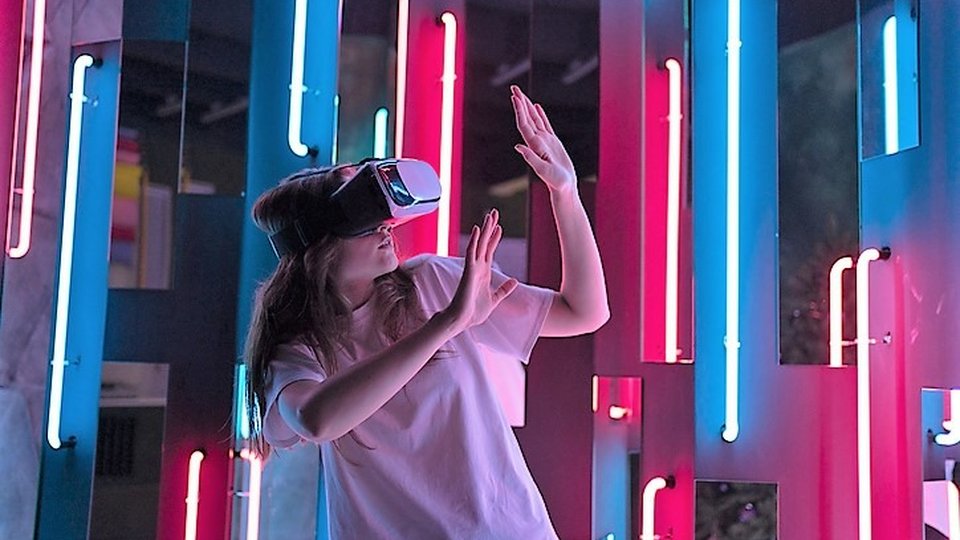Commentary
Projection versatility drives mid-size entertainment venues
Immersive technology is needed to meet the needs of consumers longing to be entertained in smaller spaces following the pandemic. Technology providers rise to the challenge.

July 19, 2021 by Kevin Williams
The popularity of free-roaming and hyper-reality experiences is a strong trend for the current location based entertainment virtual reality scene. Backpack PC, multiplayer, arena-scale experiences have seen considerable growth, and this looks to continue.
Verizon has partnered with Dreamscape on game and educational VR experiences on its innovative 5G network architecture and mobile edge computing. This offers a backpack-free and tether-less VR solution for training, education and entertainment, and the partnership is intended to promote the opportunities represented by low-cost VR streaming capabilities.
Synthesis VR, a VR location-smart game distribution, licensing and management solution provider, added a dedicated range of next generation free-roam content to its library. The company has been working with independents in the VR LBE content scene and launched a dedicated library of platforms for LBE operators of varying requirements. The company offers standalone and full backpack PC VR systems, representing Holomia, Secret Location, The Park and other independent developers.
Maxflight's two-seater system offers both passive and interactive configurations, with the company recently debuting an open-top variant that uses VR headsets rather than an internal projection screen. The system is a pure flight simulator allowing budding pilots to select from 100 different airframes, flown from virtual representations of real-world airports and able to take part in dog fights between connected machines.
Audio video advances
Meanwhile, advancements in the audio video sector have continued. Panasonic held an online event at the end of March to promote its efforts in the LB scene with its projection range.
The first guest on the virtual stage was the Panasonic's partner start-up, Illuminarium. The immersive projection experience project adapted an ultra-short-throw lens for the latest "RQ50K" digital laser light projection system in native 4k to define the experience. The first Atlanta facility is now scheduled to open on July 21.
The company is scoping the 10 cities in the U.S. to house a space and has a rollout plan for the first five. including the one already revealed Las Vegas, and planned Miami openings. Illuminarium will look towards a ticket price scale between $20 to $35.
Panasonic also gave a technology overview of the needs its projection hardware addresses in this sector, including better contrast ratio, depth of field and obviously good-looking image. This points to the need for live events to compensate for ambient light, such as a projector that can address the color imbalance.
It further revealed a highspeed tracking system (low latency), bringing the fast refresh rates needed in video games to the theme park and attraction landscape. This will be seen in 3D systems and dark rides from the start, addressing the issues being seen with polarized 3D systems with an internal depolarizing filter for passive 3D systems. The company is also looking at a new filter approach for passive 3D, opening a door to this kind of experience.
Panasonic's highspeed-tracking system allows the creation of seamless projection mapping on moving objects, opening a new world of opportunity for mixed reality immersion with physical objects (tracking achieved through an IR light camera in real-time). This marks a moment in the creation of "synthetic environments" and is a technology that will play a pivotal role in future entertainment applications.
What's next?
In another session, Panasonic gathered on stage chief executives from Alterface Projects and Jora Vision to discuss the needs and impacts of the LBE sector going forward.
Jora Vision pointed to the impact on capacity numbers for many parks that have reopened, and the acceptance of virtual queuing. The designers still want to create beautiful queue lines, but their duration will be impacted by the migration to virtual queue lines.
These seem to be a part of the future of the business, although there is an issue of bringing the attraction to the people who are not travelling to the larger entertainment venues. Smaller but high-quality experiences are needed that will be fed using this kind of immersive projection technology.
Visitor experiences need to offer a greater reason to entice the audience away from their digitally laden homes. They need to have a meaningful immersive experience. AV spectacles are being used to expand the physical world, as seen with large theme park attraction projects employing never seen before effects. But the latest technology is now allowing much more flexibility for smaller attractions.
Compact setups are based on the AV spectaculars, scaled down for a wider market.
Jora Vision pointed to the use of VR to offer disabled guests a chance to experience the larger ride attraction experiences being employed at some parks.
Alterface, for its part, focuses on four key elements when developing new attractions: "having fun," "immersing people," "sharing in a group" and finally "offering a social experience." The ability to allow the guest to change the course of this narrative, employing new technology on tracking and mapping, will drive this innovation.
In search of user friendly experiences
In conclusion, Panasonic questioned what the next big thing for projection tech will be — agreeing that the market will always strive for higher resolution, tailored for specific user cases; and where the large parks were the focus, the ability of targeting versatility for mid-size entertainment venues is a new driving factor.
The future also now seems to point to easy interactivity, with the content driving investment and being encouraged by the market. The new high-speed tracking will open up this application, including interactive elements building on feedback from their customer bases. There is a need for the adoption of new technology to offer a better shared experience, while augmented reality is seen as an inspiring new opportunity.
The collaboration of a technology provider and experience developers is the way forward. One of these new trends fueled by this technology is "art-tainment" — art driven experiences such as the pop-up Amsterdam Museum "Van Gogh: The Immersive Experience" art installation, drawing 1.4 million visitors during its Paris run. This reveals an example of the drive in smaller but still impactive experiences for people to explore. This is what some are describing as "experiential" entertainment, moving from restrictive headset immersion to socially inclusive, large projection venue concepts starting to be rolled out.
(Editor's note: Extracts from this blog are from recent coverage in The Stinger Report, published by KWP and its director, Kevin Williams, the leading interactive out-of-home entertainment news service covering the immersive frontier and beyond.)
About Kevin Williams
Along with advisory positions with other entrants into the market he is founder and publisher of the Stinger Report, “a-must-read” e-zine for those working or investing in the amusement, attractions and entertainment industry. He is a prolific writer and provides regular news columns for main trade publications. He also travels the globe as a keynote speaker, moderator and panelist at numerous industry conferences and events. Author of “The Out-of-Home Immersive Entertainment Frontier: Expanding Interactive Boundaries in Leisure Facilities,” the only book on this aspect of the market, with the second edition scheduled for a 2023 release.







